Gravel paths winding through native blooms, wooden fences draped in vines, and porch views that invite slow mornings—these familiar sights define the charm of well-executed farmhouse landscaping. With outdoor living spaces becoming increasingly valuable, the right layout can offer both functionality and visual appeal without demanding high maintenance. Whether you’re updating a rural homestead or adding character to a suburban lot, smart design choices can make all the difference. From practical plantings to rustic hardscapes, this guide highlights inspiring yet doable upgrades that enhance curb appeal and bring cozy charm outdoors. Scroll on to find ideas that feel both grounded and timeless.
Reclaimed Wood Pergola with Climbing Vines

Sun-soaked afternoons feel more serene beneath a pergola constructed from salvaged timber. The aged texture of reclaimed wood adds authenticity to farmhouse landscapes, effortlessly blending into both manicured and wild settings. When paired with climbing vines like wisteria, clematis, or grape, the visual impact deepens—offering filtered light, seasonal color, and cooling shade. This eco-conscious approach isn’t just stylish but also practical. Reclaimed lumber tends to be denser, providing durability against weather changes. Integrating such a structure into garden corners or outdoor dining zones also invites multifunctional use. Beneath its leafy canopy, place Adirondack chairs or rustic tables to curate an informal gathering spot. The organic growth above and the earthy texture below evoke a sense of timeless charm. Additionally, planting flowering or evergreen vines ensures year-round interest. For structural support, use sturdy joists and posts anchored in concrete. Leave the surface untreated to naturally gray over time, or apply a sealant for longevity. Lighting elements such as Edison bulbs or lanterns can also be looped through the beams, making evenings just as inviting. In farmhouse landscaping, few features capture rustic romance and purposeful design quite like a vine-laced pergola rooted in reclaimed materials.
Galvanized Steel Planters for Edible Gardens
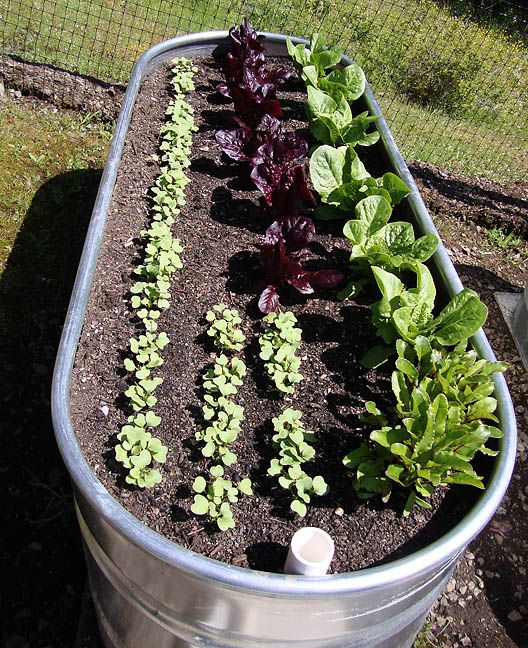
Raised planters fashioned from galvanized steel provide a sleek yet rustic edge that complements farmhouse aesthetics. Unlike wooden beds, steel resists rot, pests, and weather-induced warping—making it an ideal material for vegetable and herb gardening. Their reflective surface also helps regulate soil temperature, which benefits early-season crops. These containers are not just about function; they double as visual anchors, especially when arranged symmetrically along a gravel walkway or porch perimeter. Elevate curb appeal by filling them with heirloom tomatoes, kale, chard, or edible flowers like nasturtiums and calendula. For those aiming to grow their own produce while maintaining a polished aesthetic, these planters strike the right balance. Drainage holes are essential to prevent root rot, and layering with gravel and organic compost ensures healthy growth. Their height also reduces strain on the back, making maintenance more accessible. Pair with vintage watering cans, antique spigots, or a trellis system to enrich the visual story. Group multiple containers by crop type or color palette for a well-ordered appearance. Whether installed in tight courtyards or expansive lawns, galvanized steel planters prove that practical gardening can still carry high design value—rooted in both performance and timeless farmhouse charm.
Gravel Pathways with Native Plant Borders
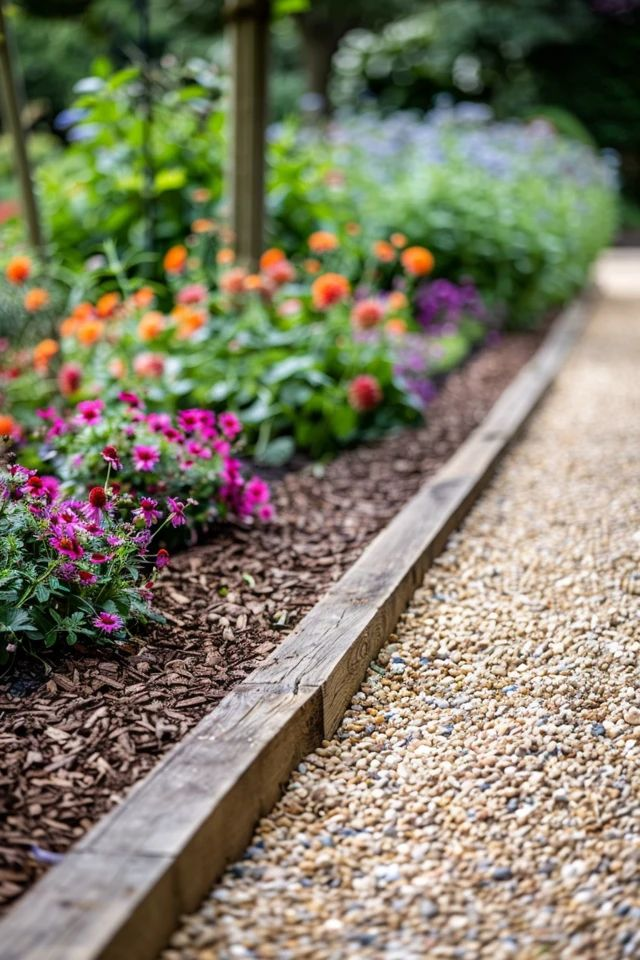
Footpaths laid with crushed gravel offer a naturally informal texture underfoot and require little upkeep. When flanked by native plantings, they invite pollinators, improve biodiversity, and mirror the organic flow of rural settings. These borders aren’t just decorative; native species are more drought-tolerant and resilient, making them an eco-wise solution. Consider pairing purple coneflowers, black-eyed Susans, and feather grasses along curved or meandering paths for a layered, immersive look. Gravel pathways also allow excellent drainage and suppress weeds better than bark mulch when installed with a weed barrier. For added structure, steel or stone edging helps define clean lines while retaining the gravel in place. Placement matters—allow pathways to guide guests toward focal points like seating zones or arbors. Lighting can be integrated via solar stakes or low-voltage fixtures to highlight the route after dusk. Each step feels connected to nature, grounding visitors in the rustic rhythm of farmhouse life. The blend of loose stone underfoot and resilient green at eye level fosters both movement and tranquility. This harmonious pairing of hardscape and softscape proves invaluable for homeowners looking to reflect their regional environment while keeping landscape design refined yet approachable.
Rustic Stone Fire Pit Gathering Area

Evenings feel more connected when centered around an outdoor fire pit framed with natural stone. This element turns open space into a functional retreat, perfect for storytelling, roasting, or simply unwinding. Select locally sourced stones to stay aligned with the farmhouse’s earthy, grounded aesthetic. Opt for circular or square layouts, depending on space, and ensure the base uses gravel or fireproof bricks for safety and stability. Surround the structure with wooden benches, salvaged stumps, or weatherproof cushions to complete the intimate setting. Native grasses, herbs like rosemary, or lavender planted around the border infuse the air with calming scents. Consider building low stone walls that double as seating while keeping the area open to panoramic views. To maintain practicality, store firewood nearby in a galvanized bin or under a timber lean-to. Fire pits should always follow safety regulations and be positioned away from flammable structures or overhanging trees. With proper planning, this backyard feature becomes a timeless focal point for all seasons. It encourages togetherness, reflects agrarian heritage, and seamlessly integrates into rural landscapes. Nothing pairs better with starry skies than the warmth and rustic beauty of a hand-built fire feature rooted in natural materials.
Vintage Farm Equipment as Garden Art

Retired tools from agricultural history deserve a second life as conversation-starting focal points in farmhouse gardens. Rusted plows, steel wheelbarrows, or hand-cranked seeders introduce texture and nostalgia while reminding visitors of the land’s legacy. These pieces often feature intricate craftsmanship that modern tools lack, making them ideal candidates for upcycled displays. Position them against fencing, within wildflower beds, or near barn structures to keep the visual story coherent. A hay rake or sickle mower partially enveloped by ornamental grasses gives a compelling juxtaposition of old and alive. Seal metal items with clear coat to preserve patina without accelerating decay. Pair with climbing vines or tuck them into gravel nooks to soften edges. Avoid overcrowding—each piece deserves breathing room to be appreciated fully. These relics offer more than charm; they add authenticity and showcase resourceful design thinking. Repurposing vintage farm gear honors rural traditions while avoiding the waste of disposal. Whether as standalone pieces or integrated into planters and trellises, their form and function tell a deeper story—one rooted in generational stewardship of the land. This approach not only beautifies but also personalizes, turning passive landscapes into storied environments brimming with character.
White Picket Fence with Lavender Hedges

Few combinations evoke farmhouse imagery more effectively than a picket fence paired with fragrant lavender. The crisp lines of a freshly painted fence contrast beautifully with the soft sway and purple hues of blooming hedges, establishing both structure and sensory appeal. Lavender thrives in well-drained soil and sunny conditions, making it ideal for lining boundaries. Beyond aesthetics, this pairing serves practical purposes—lavender acts as a natural pest deterrent and requires minimal upkeep. The fence creates visual cohesion around garden beds, walkways, or front yards while the lavender softens the scene with color and scent. Planting in staggered rows encourages dense growth and provides depth. Prune annually after flowering to maintain neat shapes and stimulate blooms. Consider interspersing with white daisies or silver artemisia to extend seasonal interest. This classic farmhouse feature doesn’t rely on novelty; it resonates because of its timeless charm and eco-functionality. For homeowners looking to create a welcoming front garden or section off areas with grace, the union of white pickets and aromatic hedging delivers enduring appeal. The effect is peaceful, structured, and rooted in traditions that value beauty with purpose—offering form, fragrance, and a finishing touch with broad curb appeal.
Tiered Raised Beds Using Reclaimed Timber

Stacked garden beds built from reclaimed wood bring both height and history to planting areas. This design optimizes limited space, enabling gardeners to layer crops vertically and improve drainage across tiers. Old barn siding, shipping pallets, or salvaged beams make ideal candidates—offering texture, character, and sustainability. When arranged in pyramid or stair-step formations, the beds provide clear access to each planting zone while creating an eye-catching garden focal point. Seal wood with food-safe oil to extend its life without compromising plant health. Fill each tier with soil tailored to its crops—richer mixes for herbs and vegetables, lighter for flowers or succulents. To maintain visual unity, stain or leave the wood natural to weather over time. These structures not only conserve square footage but also reduce weed invasion and soil compaction. Integrate paths of gravel or mulch between beds for neat transitions. Vertical planting styles also cater to those with mobility challenges, offering ease of maintenance. This approach blends rustic resourcefulness with functional precision—suiting both aesthetic and practical needs. For farmhouse landscapes that prize both heritage and harvest, tiered raised beds built from reclaimed timber deliver abundant yield wrapped in timeless appeal.
Weathered Barn Door as Garden Entrance
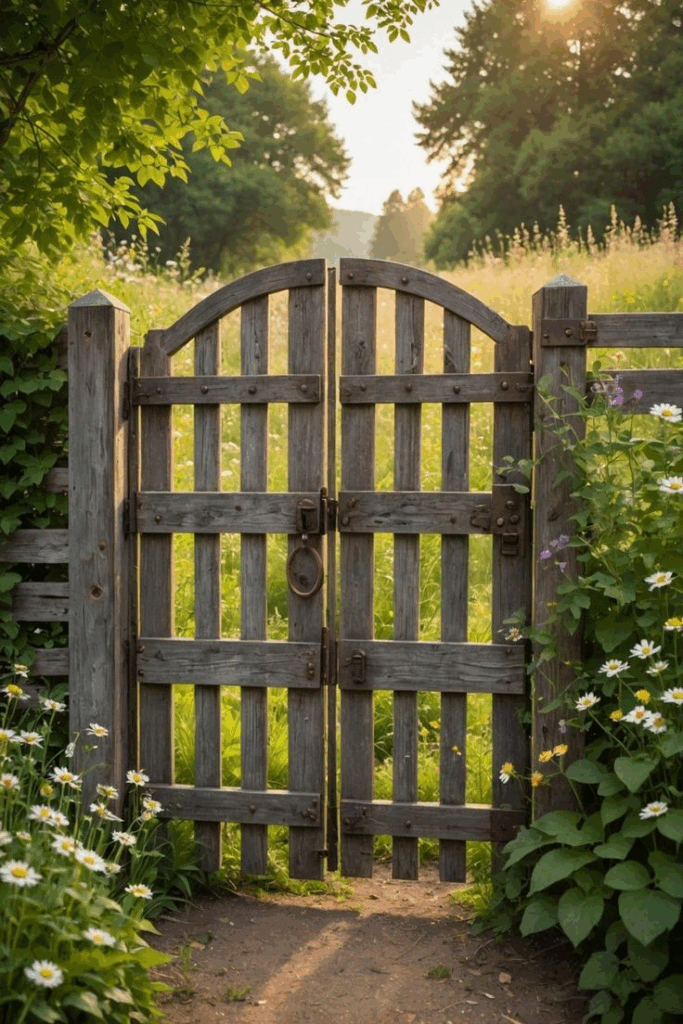
Old barn doors gain renewed purpose when repurposed into entry points that ground outdoor spaces with character. Their distressed wood, aged hardware, and substantial weight convey authenticity and timeless strength. Install upright as a single-panel gate or double-door swing between fence posts to signal a shift between zones—whether from yard to vegetable garden or from pasture to flower beds. Hinges, latches, and iron brackets can be left rusty or refinished for contrast. Surround the door with climbing roses or honeysuckle to soften edges and introduce color. Stone or gravel thresholds maintain visual consistency with rural paths. When flanked with lantern-style lighting, the structure gains nighttime charm as well. Reclaimed barn doors also serve as symbolic and literal entryways, adding storytelling to simple transitions. They stand as reminders of hard work, resilience, and design that doesn’t date. For an extra touch, mount a hand-painted sign or wreath to personalize the space further. Whether standing solo or integrated into fencing, a barn door garden entrance offers more than utility—it anchors the landscape in memory and presence. Practical, picturesque, and perfectly at home in farmhouse settings, this upcycled detail turns any path into a moment worth pausing for.
Rainwater Harvesting Barrels with Floral Accents
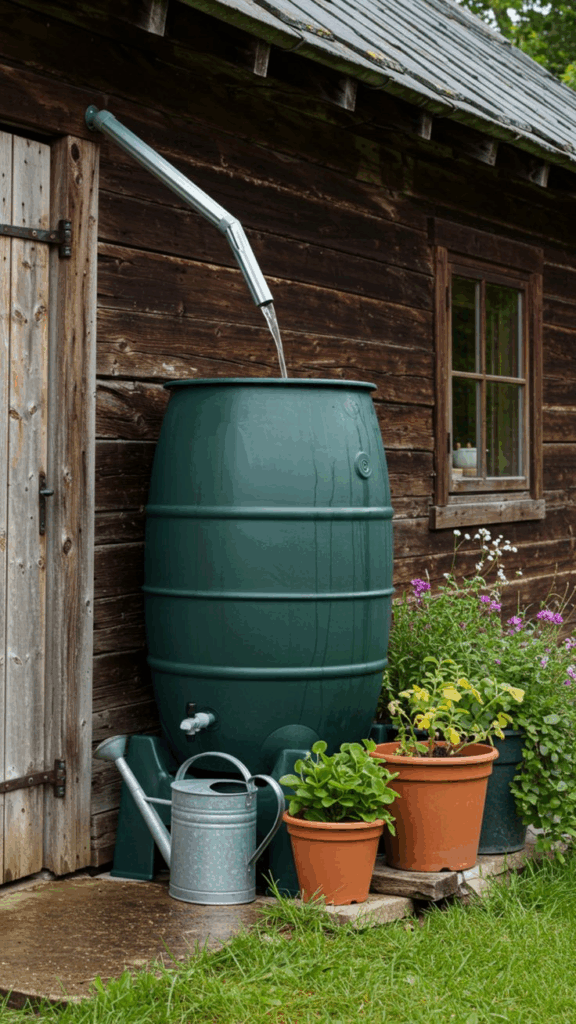
Sustainable design finds harmony in farmhouse landscapes through rain barrels paired with blooms. These practical tools capture runoff from roofs, conserving water for garden use while easing strain on local supplies. Choose barrels made of repurposed wine casks, food-grade drums, or vintage metal tubs for added charm. Situate beneath gutter downspouts, then embellish with wood cladding, painted stencils, or flower boxes for a softer appearance. Surround bases with low-maintenance plants like hostas, echinacea, or creeping thyme to blend function with beauty. Spigots should be easily accessible for filling watering cans or attaching hoses. Include mesh lids to prevent mosquito breeding and debris accumulation. This approach merges sustainability with farmhouse character, promoting eco-minded gardening without sacrificing aesthetics. For larger plots, link multiple barrels together to maximize capacity. Painted finishes in muted tones like sage, charcoal, or antique white help them recede visually while still offering decorative appeal. Pair with vintage watering cans or iron wall brackets to complete the look. Rainwater harvesting becomes more than just responsible practice—it becomes a visual asset when thoughtfully styled. These small, grounded changes encourage greener habits and let homeowners steward their landscapes with both style and intention.
Outdoor Dining Area with String Lights
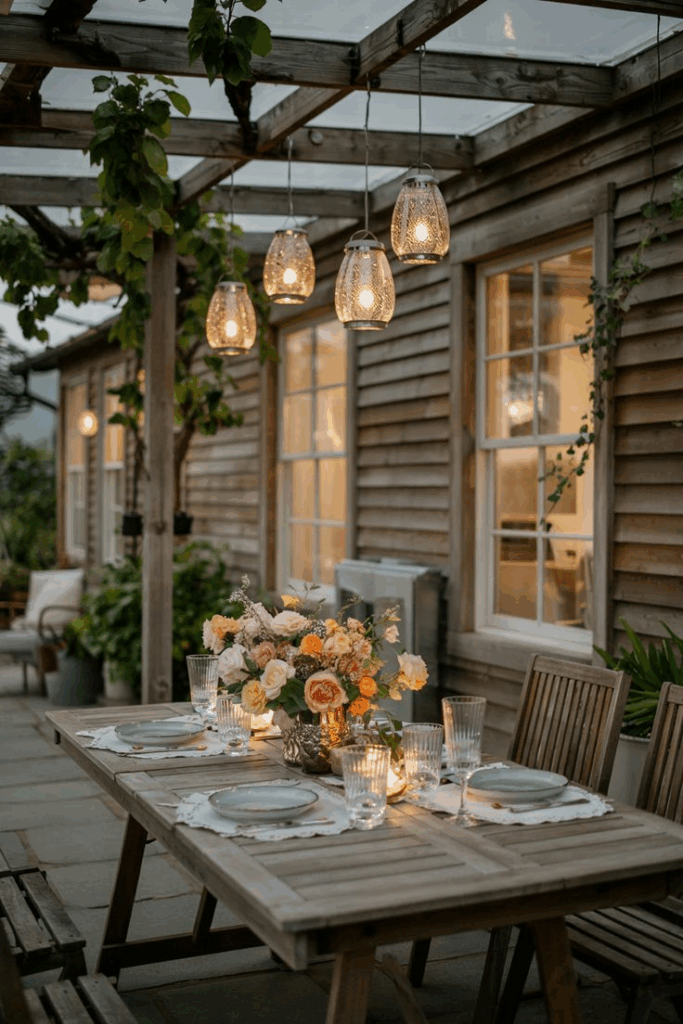
Shared meals feel more memorable beneath a farmhouse sky lit by warm string lights. Whether suspended above a reclaimed wood table or zigzagging across open space, these glowing strands establish intimacy and charm. Pair them with exposed Edison bulbs for a nostalgic ambiance or solar-powered options for efficiency. The dining setup itself can range from full tablescapes with vintage dishware to simple benches circling a central table. Gravel or paver foundations provide durability while delineating the zone. Surround the perimeter with potted herbs, hanging baskets, or planter boxes to introduce greenery and fragrance. For shade, consider a pergola, fabric canopy, or vine-covered trellis to add vertical interest. Include candle lanterns or hurricane lamps to soften lighting further. Durable materials like galvanized chairs, reclaimed barn tables, and weatherproof textiles reinforce the farmhouse theme while withstanding the elements. Placement is key—situate near the kitchen or grilling station for ease. This space becomes a setting for seasonal dinners, family celebrations, and quiet moments alike. It’s where rural life meets hospitality, and casual gatherings find a curated touch. Simple lighting, natural textures, and good company turn any backyard into a lasting memory under the stars.
Wildflower Meadows for Pollinator Support

Biodiversity flourishes when native wildflowers take root in open areas of a farmhouse yard. These untamed stretches reduce mowing needs and provide a vital sanctuary for bees, butterflies, and hummingbirds. Choose regionally appropriate seed mixes that bloom across seasons—think black-eyed Susans, bee balm, yarrow, and coreopsis. Scatter across a sunny field, sloped lawn, or property border to mimic natural prairies. Once established, these meadows require little watering or maintenance. Mow only once or twice annually to manage height and encourage reseeding. The organic, flowing nature contrasts beautifully with the neat lines of outbuildings, fences, or garden beds. Include a small walking path or stone bench to allow appreciation up close. Wildflower zones not only benefit local ecology but also elevate visual texture with constantly shifting color and form. For an added boost, install bee houses or shallow water basins nearby. This landscaping strategy redefines beauty through ecological balance, supporting declining pollinator populations while enhancing property charm. Instead of manicured turf, the land becomes a living system—resilient, adaptive, and visually dynamic. A wildflower meadow celebrates the quiet power of natural design, making it one of the most rewarding additions to any farmhouse setting.
Repurposed Window Frames as Trellises
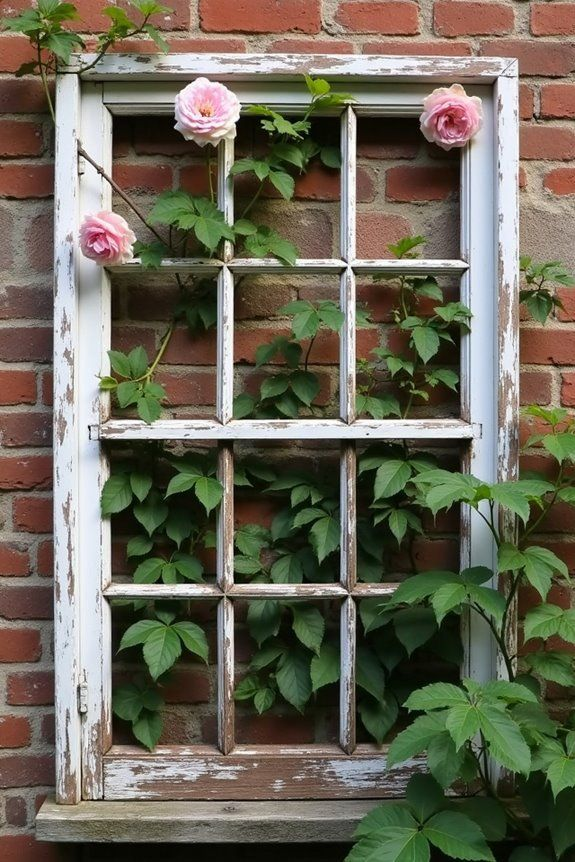
Vintage window frames bring rustic personality and vertical interest to gardens when converted into trellises. Salvaged from barns or old farmhouses, these pieces already carry age and charm, making them natural companions to climbing plants. Stand them upright along fences, attach them to shed exteriors, or suspend them between posts. Use for supporting beans, morning glories, sweet peas, or clematis—allowing vines to weave through openings for a whimsical effect. Their segmented panes naturally guide plant growth while adding architectural contrast to softer elements like wildflowers and grasses. Apply a weatherproof finish if placing in exposed areas, or let the paint peel naturally for a timeworn patina. For sturdiness, reinforce frames with rebar or stakes driven deep into the soil. Cluster in odd numbers to create visual rhythm, or frame them like garden portraits behind a bench or seating nook. These repurposed elements celebrate sustainable design and offer new life to discarded pieces. They’re especially powerful in farmhouse landscapes, where every material tells a story. Functional yet poetic, window-frame trellises blur the line between garden art and utility—making vertical growing not only accessible but visually impactful. They contribute charm without clutter, standing quietly while plants take the spotlight.
Natural Stone Retaining Walls with Integrated Seating
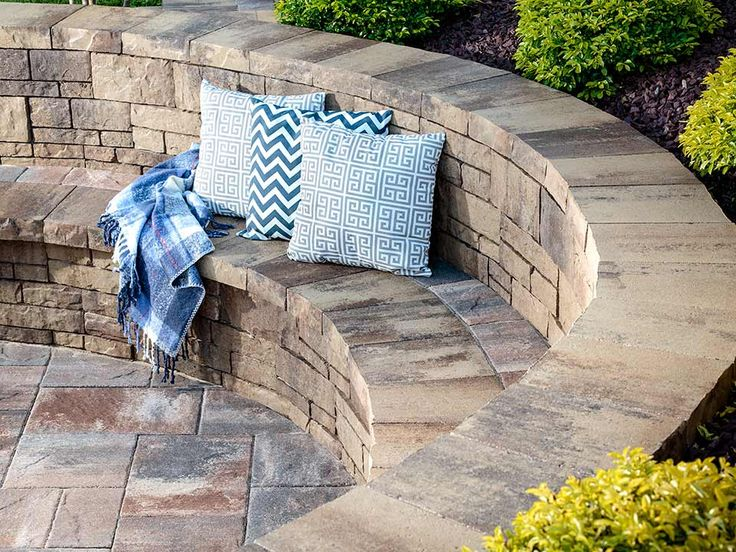
Grading challenges and sloped land benefit from the strength and elegance of stone retaining walls, especially when topped with bench-style seating. These dual-purpose structures offer support for elevated garden beds or terraces while creating places to rest and gather. Use locally sourced fieldstone or limestone for visual cohesion with rural surroundings. Dry-stacked or mortared methods depend on height and climate, but both evoke permanence and simplicity. Design the top ledge to be wide and smooth enough to accommodate seating—ideal for enjoying garden views or sipping morning coffee. Incorporate creeping thyme or trailing sedum between stones to soften edges. These living accents also help prevent erosion and add fragrance. For nighttime ambiance, consider embedding solar lights into the wall or positioning lanterns along the base. Strategically place near fire pits, pergolas, or water features to extend the function of nearby zones. This hardscape solution proves that utility and beauty need not be separate. It grounds the garden in both form and function, supporting the landscape while inviting people into it. In farmhouse settings where ruggedness meets grace, retaining walls with integrated seating speak to the practicality of rural design married with aesthetic foresight.
Herb Spiral Garden for Culinary Use
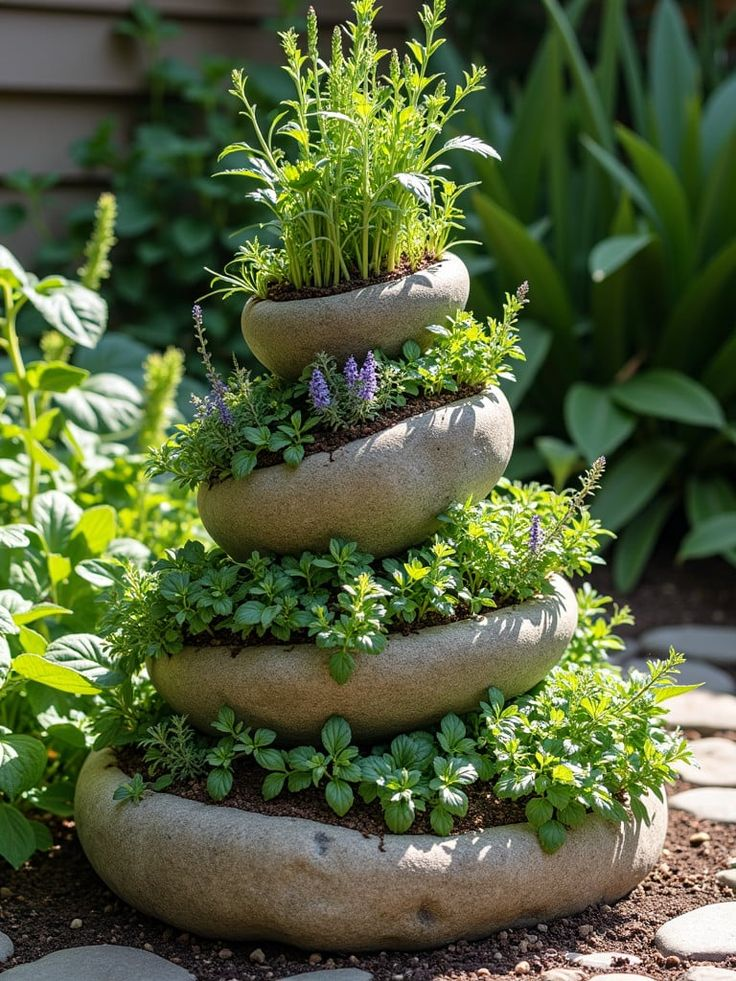
Gardeners with limited space can still achieve productivity and style by constructing an herb spiral—a raised, circular bed arranged in a coil that ascends toward the center. This shape creates microclimates: the top receives more sun and drainage, perfect for rosemary or thyme, while the bottom retains moisture, suiting mint or parsley. Build using reclaimed bricks, rocks, or logs to maintain a farmhouse-friendly appearance. Fill with nutrient-rich soil and compost, layering gravel or sand for drainage as needed. The spiral design makes harvesting easy and visually intriguing from any angle. Place it near the kitchen door or outdoor dining space for convenient access during meal prep. Surround the base with flagstone, mulch, or gravel to reduce weeds and create a clean perimeter. Add a decorative touch with a sundial or garden marker at the top. These spirals maximize growing surface in compact areas, supporting a diverse array of herbs within a small footprint. They also promote healthy root growth by mimicking natural water flow and soil temperature gradients. Whether installed in backyard plots or front-yard accents, herb spirals deliver function with artistry—perfect for farmhouse enthusiasts seeking beauty, utility, and a touch of permaculture wisdom.
Solar-Powered Lanterns Along Walkways
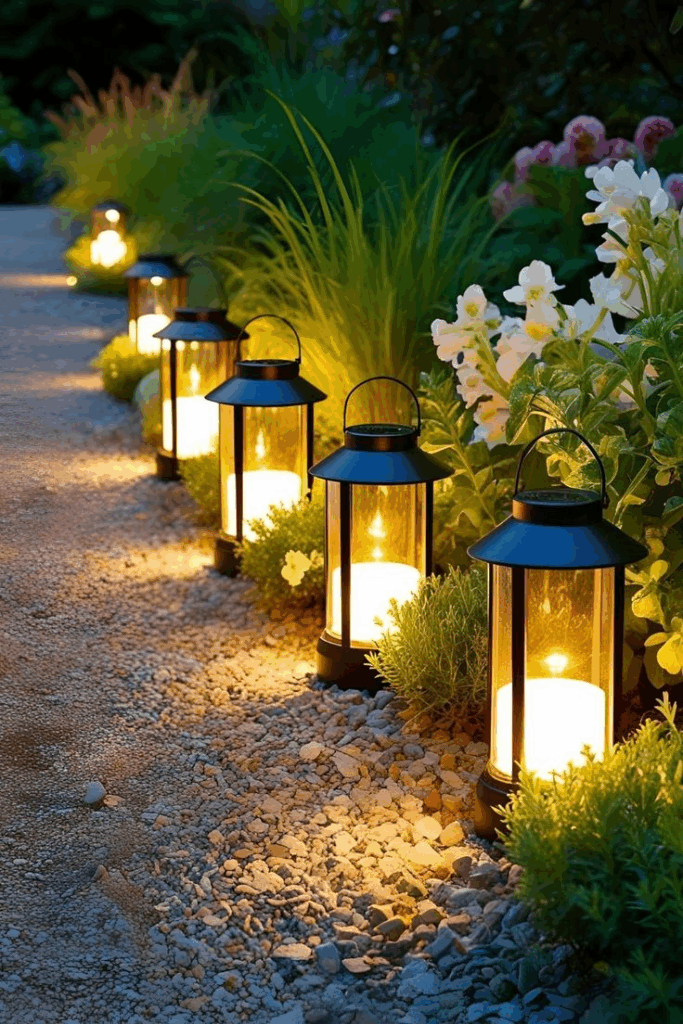
Evening ambiance gains a rustic upgrade when solar lanterns guide the way through farmhouse gardens. These energy-efficient lights require no wiring and charge during the day to provide soft, warm glows after sunset. Choose lanterns with weathered metal finishes or vintage glass styles to align with farmhouse aesthetics. Stake along gravel paths, line garden borders, or hang from shepherd’s hooks near seating areas. Their flickering presence not only enhances safety but also adds a magical undertone to the landscape. For longevity, opt for models with durable casings and replaceable LED modules. Position lanterns at staggered intervals to mimic natural rhythm and avoid visual clutter. Mixing different heights can increase depth and visual interest. Combine with other elements like wooden signs, native flowers, or fencing to tie the design together. These lights prove especially useful near outdoor dining zones, pergolas, or fire pit areas—guiding guests without overwhelming the natural scene. Solar lanterns strike a balance between sustainability and style, illuminating walkways while respecting the simplicity of rural living. In farmhouse landscapes that prioritize understated charm, this lighting solution adds just enough glow to transform outdoor evenings into memorable, mood-rich experiences without the need for electricity or maintenance.
